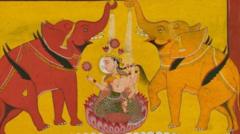A new exhibition at the British Museum in London, titled "Ancient India: Living Traditions," is drawing attention to the profound evolution of spiritual art in India. This remarkable showcase features 189 artifacts that span across centuries, allowing visitors to delve into the diverse representations of divine and nature spirits from ancient times.
From sculptures680 and manuscripts to vibrant gouache paintings, the exhibition highlights the artistic transformations that took place from 200 BC to AD 600 in the Indian subcontinent. The imagery began as symbolic representations of deities and evolved to more human-like forms, reflecting the shared cultural influences of Hinduism, Buddhism, and Jainism. "Today, we cannot imagine these divine entities without human forms, which is what makes this transition so fascinating," explains Sushma Jansari, the exhibition's curator.
Visitors can engage with a carefully-curated journey through five distinct sections, tracing the roots of nature spirits and the artistic developments within each of the three religions. The exhibit further examines the dissemination of these artistic traditions beyond India, impacting regions like Cambodia and China.
One of the standout pieces is a two-sided sandstone panel illustrating the evolution of the Buddha’s representation. One side showcases a human form with intricate details dating back to around AD 250, while the opposing side depicts earlier symbolic forms like a tree and footprints, highlighting a pivotal shift in religious art. As Jansari notes, having this transition captured in a single piece is remarkable.
Additionally, the Hindu section displays a bronze statue that showcases the evolution of goddess imagery, merging elements of nature spirits and divine forms. Jain art is also prominently featured, focusing on the 24 enlightened teachers known as tirthankaras with visually stunning representations.
The exhibition is distinct as it unites the artistic traditions of three different religions rather than presenting them in isolation, shedding light on the profound connections and similarities between them. It includes artifacts that have traveled across time and borders, emphasizing transparency about their origins and journeys to the museum, with particular attention to the contributions of female donors to Buddhist art.
The showcase goes beyond ancient artistry, providing a multi-sensory experience with scents, colors, and nature sounds that evoke the spiritual ambiance of active religious spaces. "I aimed to create a calming and serene experience reflecting the sacredness of these traditions," Jansari remarks.
The exhibition is not merely about historical art, but it cementss the relevance of these living traditions to millions worldwide today. "We are not just looking back; we are reflecting on a continuous cultural legacy that remains significant," she concludes. "Ancient India: Living Traditions" runs at the British Museum from May 22 to October 19, drawing on the vast South Asian collection and loans from numerous international museums and libraries.

















